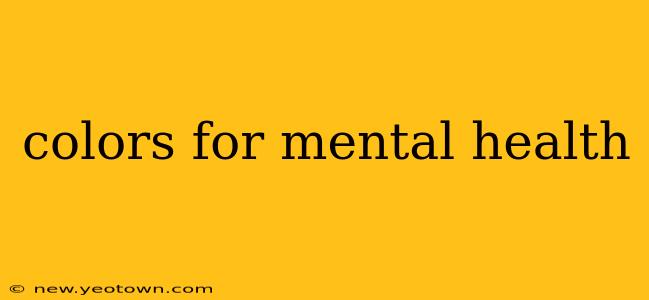The Unexpected Power of Color: How Hues Impact Mental Well-being
Have you ever noticed how certain colors make you feel? A sunny yellow might lift your spirits, while a deep blue might evoke a sense of calm. This isn't just subjective; the impact of color on our mental health is a fascinating and increasingly researched area. It's a subtle yet powerful influence that shapes our moods, productivity, and even our sense of well-being. This isn't about prescribing colors as a cure, but rather understanding how we can leverage their inherent power to cultivate a more supportive environment for our mental health.
Let's delve into the world of color and its surprising connection to our emotional landscapes.
What Colors Are Good for Mental Health?
There's no single "magic bullet" color for mental well-being. The impact of color is deeply personal and influenced by individual experiences and cultural backgrounds. However, some colors consistently demonstrate positive associations with mental health:
-
Blue: Often associated with calmness, tranquility, and serenity. Blue is frequently used in therapeutic settings to promote relaxation and reduce stress. Think of the soothing feeling of a clear blue sky or the calming effect of the ocean. It can help lower blood pressure and heart rate, promoting a sense of peace.
-
Green: Evokes feelings of nature, growth, and renewal. Green is known for its restorative qualities. Spending time in nature, surrounded by green, has been scientifically linked to reduced stress and improved mental well-being. Bringing elements of green into your home, through plants or décor, can tap into this restorative power.
-
Yellow: Often associated with happiness, optimism, and energy. However, overuse can be overwhelming. In moderation, yellow can brighten a space and boost mood, acting as a gentle mood elevator.
-
Lavender (Purple): This calming color promotes relaxation and reduces anxiety. It's a sophisticated blend of blue and red, combining the calming aspects of blue with the energetic qualities of red (in a subdued way).
What Colors Are Bad for Mental Health?
While no color is inherently "bad," certain colors can be overstimulating or negatively associated with certain emotional states depending on the individual:
-
Red: While stimulating and energizing for some, excessive red can be overwhelming and even aggressive. It can raise blood pressure and heart rate, which can be detrimental to those already experiencing anxiety or stress.
-
Black: While associated with sophistication and elegance, black can evoke feelings of darkness, sadness, or isolation, particularly in large quantities. A balanced use is key.
-
Grey: While neutral and versatile, an overabundance of grey can feel cold, sterile, and depressing. It's crucial to balance grey with other warmer colors.
How Can I Use Color to Improve My Mental Health?
The good news is that you don't need a complete interior redesign to harness the power of color. Simple changes can make a big difference:
-
Surround yourself with nature: Spend time outdoors, or bring elements of nature – plants, flowers, natural light – inside.
-
Mindful color choices: Pay attention to how different colors make you feel. Experiment with incorporating colors that evoke positive feelings into your environment.
-
Create a calming sanctuary: Designate a space in your home – even a corner – as a relaxing retreat. Use calming colors like blue, green, or lavender to promote relaxation and stress reduction.
-
Color therapy: While not a substitute for professional help, color therapy is a complementary approach that uses color to influence mood and emotional state.
Can Color Therapy Cure Mental Illness?
No. Color therapy is not a replacement for professional mental health treatment. It's a complementary therapy that may help to improve mood and well-being, but it's crucial to seek professional help from a qualified mental health professional for serious mental health conditions.
What are the Benefits of Using Certain Colors in Therapy Rooms?
Calming colors like blue and green are often preferred in therapeutic settings to create a relaxing and supportive atmosphere for clients. These colors are thought to reduce anxiety and promote a sense of peace, which can be beneficial for individuals seeking mental health support.
In conclusion, the relationship between color and mental well-being is complex and multifaceted. It’s not about strict rules, but about conscious awareness and mindful application. By understanding the subtle influence of color, we can create environments that support our mental health and nurture our overall well-being. Remember, if you're struggling with your mental health, seeking professional help is crucial. The power of color can be a valuable tool, but it should always be considered alongside other important mental health strategies.

